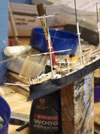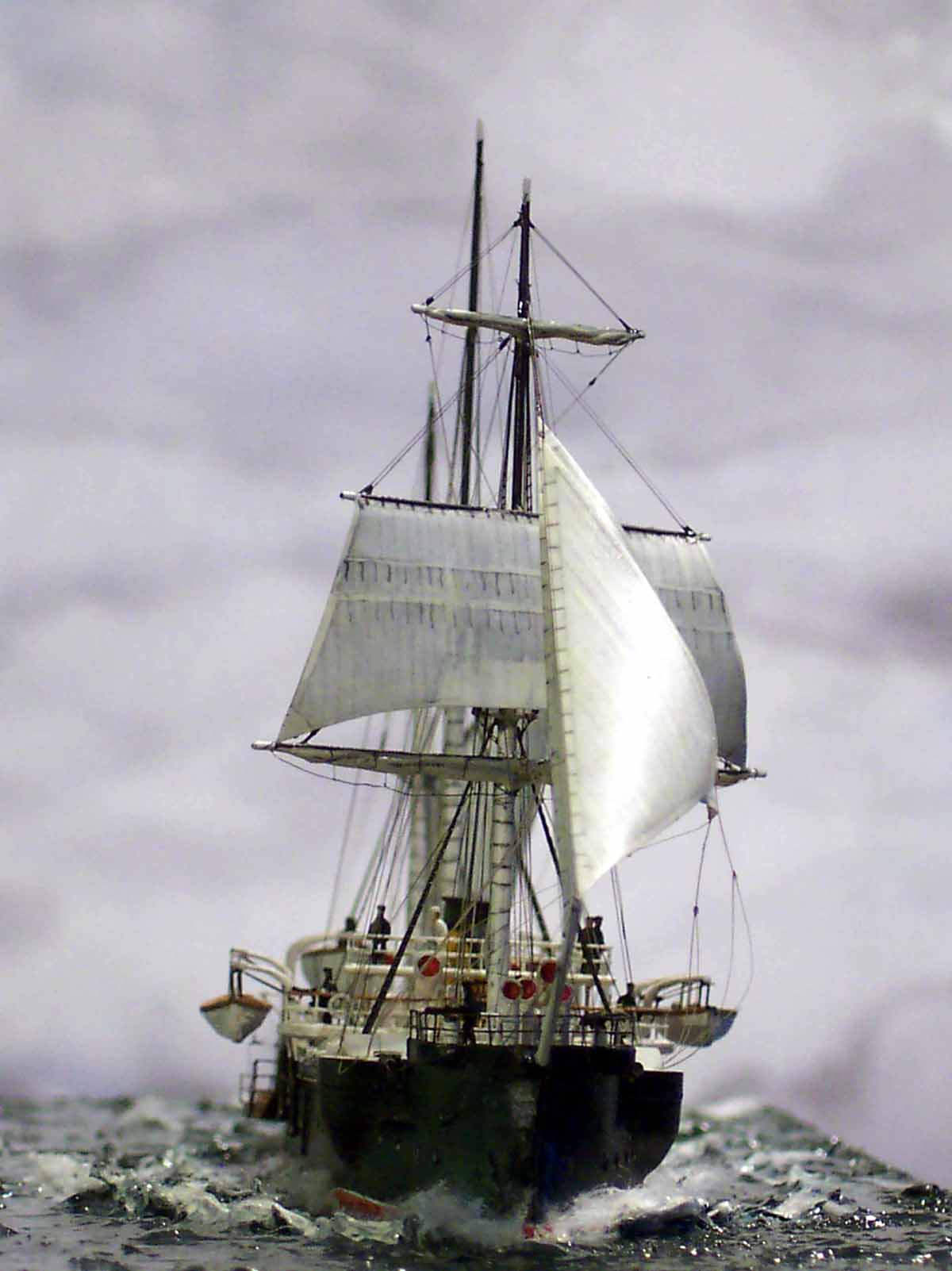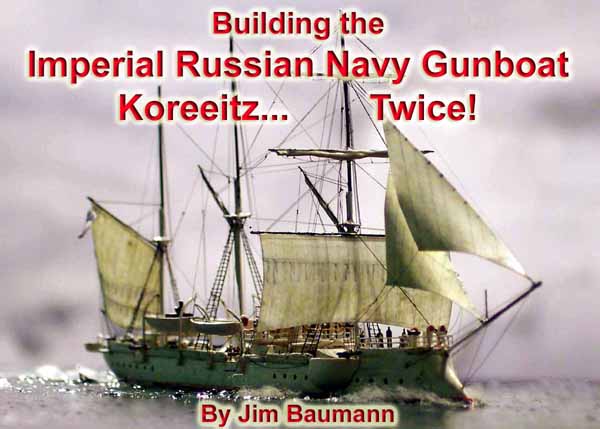| It was my love of the reverse sheer shape of the ramming
bow that inspired me to build this ship. So much so that after aquiring
the Combrig kit in 1/700 from WEM I knew I just had to have the Box 261
1/350 variant as well! This was supplied by NNT of Germany. Knowing I would
be unlikely to repeat-build two models of the same subject after each other,
even seperated by another project the decision was taken to build them
simultaneously, which was an instructive and interesting process. I performed
most tasks and functions on the 1/350 version first ,then repeated them
on the 1/700 model forearmed by knowing how to cope with the pitfalls but
having to miniaturise the processes for everything. |
|
|
| Koreeitz and her sister Mandjur were not large ships, at
219' loa , she was armed with 2 x 8" guns in the fwd sponsons and 1 x 6"
in a turret aft along with 4 x 4.2" , 2 x 3pdr and 4 x 1pdr revolvers as
well as a 15" TT . Two shafts coupled to reciprocating steam plant pushed
her along at a maximum of 13.3 knots. Koreeitz was completed in 1887 at
Bergsund , Stockholm Sweden.. In 1/700 model form this resulted in a hull
3 1/4" long, which coupled with a Barquentine rig made for a very intricate
fiddly build, especially with the huge amount of lines and ratlines and
my wish to present her with some sails set and drawing. In the later stages
of her career and the height of her fame( she fired the first shot in the
Russo-Japanese war prior to scuttling herself in shallow water at Chemulpo
in 1904) the sailing rig was cut down to stump masts at first platform
level, this would have been the easy and quick way out.... |
 |
 |
| Both kits abound with detail and character, the Combrig 1/700 model
bristles with crisp skylight detail, which in the Box 261 1/350 kit is
replicated and achieved in the main with PE brass overlays which allows
for a sharp look. The most easily accessible (and reputable) drawings are
to be found in that most useful publication' Morskaya Kollektyia' issue
1 1990, photos of Koreeitz and Mandjur are not common on the net or in
books as far as I could ascertain. |
 |
|
|
|
|
| I decided early on to present one model in white and the
other in blackhulled livery, both with some sails set (on opposing tacks!)
as this would make them visually more interesting. Paradoxically it would
appear that both ships were poor performers under sail, so I modelled them
using the sails as auxillary power to the steam plant.
Koreeitz in 1/350 is a full hull model which was waterlined on my trusty
beltsander in minutes. The kit supplies the stowed hammocks as a casting
to be applied to the bulwarks, this needs careful painting and shading
to give a convincing effect . In the 1/700 version I built up the tops
of the bulwarks with white glue to give them bulk, then pencilled in carefully
the hammock 'shadow gaps'. On both models I applied the selfadhesive tape
from RC Cammet to crisp up the shape of the stowage rails. Boat stowage
racks were scratchbuilt in fine wire on the 1/700 model then thickened
with white paint, the 1/350 version has these as PE items, both were augmented
with the fore and aft planks which the crew would have used to service
the boats. One of the high points of the 1/350 kit has to be the steering
wheels, rendered beautifully in PE, this inspired me to do the same in
1/700, I used WEM items for this from their dedicated wheel fret. The 1/350
kit low point was the boat interiors, solid moulded thwarts, so much nice
PE on the supplied fret, why not thwarts? So I proceeded to cut all seats
and replace them with new styrene strip items for a lighter effect, once
furnished with oars the contrast in shades and the light playing though
the seats made the effort worthwhile I think.... |
 |
 |
|
|
| The funnels on both kits were hollowed out with a motor-tool, the steam
pipes made of brass wire and attached to the funnel usng a small dab of
white glue as in the photo . |
 |
|
|
The 8" and 6" gun splintershields in the 1/350 model are
bent up from thick Photetch parts, I heated these over a candleflame to
make the brass more pliable to allow me to achieve the double curvature(
they taper inwards at the top slighly!) in the 1/700 version they are a
one-piece casting, which I carefully painted to give the impression of
depth.
The two kits were basically identical and agreed with the plans in
MK, which avoided much headscratching! The clinker effect of the ships
boats in the 1/350 kit is subtly rendered, with a little careful pencil
accentuation it is apparent without being too obvious; this fell by the
wayside in 1/700!
At an early stage I glued the hulls to 'holders', as I like to be able
to move the hulls around to allow me to gain access to all the undercuts
prior to mounting on the seascape; I used a small block of wood for the
1/350 version and the top of a pencil in 1/700, this has the added advantage
that the model can be secured in a pencil sharpener! The removal of the
models from the holders prior to putting them 'afloat' is always a fraught
business, utilising a sharp chisel, a small hammer and an assistant with
nerves of steel; thanks Katrin! I applied the boot-topping whilst still
on the pencil, for the blackhulled version I applied first a white decal
stripe then the red boot-top striping. |
 |
 |
 |
|
|
| On the 1/700 version I cut out the 4.2" gun embrasures and represented
the dropped plates with paper items glued on in the down position to help
break up the otherwise dull sheerline. I applied the supplied PE doors
to the superstructure on the 1/350 version and used WEM items on the smaller
sister. The 1/350 railings supplied were without the waterway, these I
would have used but they were just a bit too clunky so I used GMM two bar
for the bridge and painted the teak capping rail on, and used WEM (Koenig)
items for the bow, in 1/700 I used GMM superfine. The main issue was that
the bridge decks had a lot of curvature around the edges, holding the deck
was a problem, the photo shows the solution, I heated the brass railing
with a lighter, this made it very pliable and easy to bend in situ whilst
simultaneously gluing. For symetry I cut and joined the rails on the centre
front. |
 |
| By far the most interesting aspect of this project was
the rig, this being a major part of the models appearance. I made all the
masts from brass and stainless steel tube/rod according to the plans in
MK, to include correct platforms, these were made of paper, after installation
soaked in Cyano glue, this results in a thin but strong structure cut out
with scissors! The ratlines(shrouds) are a major feature of a ship such
as Koreeitz, for the 1/350 version I availed myself to the excellent version
in Photoetch from the German firm of Saemanns , who have in their range
ratlines with and without deadeyes, with the footropes being half size
of the shroud, relief etched and relatively sturdy they are really very
useful indeed!
For the Combrig 1/700 model I resorted to wire and sprue with crossed
eyes; I am hopeful of receiving some custom-made 1/700 items soon in the
near future to obviate this torture! At the base of the masts I installed
the belaying-pinrails to take the vast amount of halyard cordage aft of
the masts, I installed some very small coils of rope to represet the tails
of the halyards . The headsail sheets were along with most of the running
rigging of a 2-1 system whereby the load effort was halved by using a block
to give the purchase, the windward sheets being unloaded simply hang.... |
|
|
| I made little paper templates for the sails which were
made of paper on which I had previously drawn in the panel lines, reef
points and corner re-einforcing (on both sides!). I had experimented with
a photocopier as well as my PC printers( alps) for the panel lines, but
they were either to fuzzy, too harsh and black or too irregular in texture,
leave alone try and get them aligned with the reverse side... so I drew
them on by eye in pencil, then taped the paper to the window and drew them
again on the reverse side. I then painted the panels with watercolours,
soaking the paper. These were then shaped to the desired profile and placed
on the radiator to dry out; when fully dry I soaked them in Cyano glue
to make the impervious to moisture in the atmosphere as well as strong.
I then highlighted some of the tabling and clew corners in whitish watercolour
as well as the reeinforcing for where the sail would chafe against the
fore top platform. |
 |
 |
|
|
After I had done the 1/350 version I felt able to tackle the 1/700
variants....
The box 261 1/350 kit supplies furled resin sails which alas look more
akin to a breadroll, so I resorted to using white glue as shown in the
photo; this has the advantage that more can be added easily whilst the
underlying layer is still not set, thereby creating a crease and or a sag... |
 |
|
The above images show the white glue oon the 1/700 sails being made and
the 'Breadroll ' like furled sails as supplied by box 261 alongsside their
white glue replacements |
 |
| One of the hardest parts was making the footropes upon
which the sailors would have stood whilst brailing the sails up, next time
I will use wire and sprue as a combo, but in this instance I ended up using
all sprue, tacking the vertical supports with liquid cement then using
the weakness created to form the 'kink' between the ' sags', the photos
illustrate the method.
On the 1/700 version I used as ever the GMM PE figures, on the 1/350 model
for the first time I tried the very impressive resin 3-D figures from L'Arsenal,
which when compared to even a ' thickened' PE figure appear so much more
dynamic and rounded(!). I will definitly be using these again. |
|
|
| All in all an amusing little project, paralell building
the same ship in two scales illustrated to me the relative merits of the
large and small, what is and is not feasible in 1/700!! The models are
visually more appealing by the use of the sails, however the sheer amount
of sprue cordage applied to both models has sent me hunting through my
kit stash for something without a mast.....!! K-class submarine?? |


